If you decide to start a home plant like Phalaenopsis, then you should be prepared for some problems with it, which not every grower can prevent.
Home orchids are tropical flowers, so they prefer a humid and warm climate; it is quite difficult to reproduce such conditions at home without special greenhouses for plants. Therefore, many indoor plant lovers often have to deal with such a problem as root rot.
Content
How to prevent root rotting?
Experts recommend growing orchids in transparent containers, this is due to the peculiarities of its life in nature. In addition its roots are clearly visible in glass potsthat turn light green when moist. When their color takes on a pale green or white hue, and the leaves wither, then the plant needs watering.
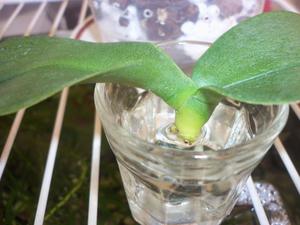 In most cases, diseases of the root system arise from improperly selected soil or too loose flowerpot when transplanting an orchid. There should not be any small particles of earth in the soil, since they can cause stagnant water, leading to root rot, and also prevent the access of oxygen to them. It is best to use a substrate that is half dry pine bark and sphagnum moss. Moreover, it is easy to cook it with your own hands.
In most cases, diseases of the root system arise from improperly selected soil or too loose flowerpot when transplanting an orchid. There should not be any small particles of earth in the soil, since they can cause stagnant water, leading to root rot, and also prevent the access of oxygen to them. It is best to use a substrate that is half dry pine bark and sphagnum moss. Moreover, it is easy to cook it with your own hands.
Other causes of problems
High humidity and poor lighting
Folenopsis has an unusual root structure. Epiphytic flowers do not have root hairs through which they receive moisture. The upper part of the root is called velamen.consisting of hollow cells. Moisture enters it through the capillaries, it is able to be pumped from one layer of cells to another until it gets to the next, which takes part in the exoderm. It is from this place that the water moves to the center of the root, and then upward - to the leaves of the flower.
For water to freely pass from the upper layer to the exoderm, certain conditions must be created. The brighter the lighting, the faster the orchid will absorb moisture.
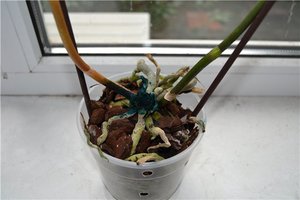 There is a problem with decay of the root system mainly in winter, since during this period there is a deficit of sunlight. In the tropics, this plant does not have to deal with a lack of sun. When there is not enough light for the flower, moisture remains in the top layer, due to which the leaves begin to turn yellow. If the root system is in well-ventilated soil, then some of the water will naturally evaporate, however, some of it will not go anywhere and can cause rot.
There is a problem with decay of the root system mainly in winter, since during this period there is a deficit of sunlight. In the tropics, this plant does not have to deal with a lack of sun. When there is not enough light for the flower, moisture remains in the top layer, due to which the leaves begin to turn yellow. If the root system is in well-ventilated soil, then some of the water will naturally evaporate, however, some of it will not go anywhere and can cause rot.
Soil compaction
Some growers do not even suspect that the substrate in which the orchid is grown should sometimes be changed. Soil over time:
- Loses its structure;
- Begins to thicken strongly;
- Crumble into small pieces.
All this will certainly affect the roots and leaves of the plant, therefore, to save the orchid, the soil must be changed periodically, avoiding compaction.
Burning the roots with dressings
 Orchids are too sensitive to fertilizing, especially to phosphorus and potassium salts. When using highly concentrated fertilizers, flower roots may burn, after which they will not be able to function normally. It is necessary to save the plant by stopping feeding and transplanting it into fresh soil.
Orchids are too sensitive to fertilizing, especially to phosphorus and potassium salts. When using highly concentrated fertilizers, flower roots may burn, after which they will not be able to function normally. It is necessary to save the plant by stopping feeding and transplanting it into fresh soil.
When performing a Folenopsis transplant, there is also a risk of damaging the root system. One cut, even a minor one, is enough to the damaged area has ceased to function and began to rot. Moreover, after a while, rot can spread to all roots, which leads to the death of the orchid.
Pest attack
If you have problems with the roots of Pholenopsis, then perhaps this is the case of the click beetles. They lay larvae in the soil, which feed on root processes. Eventually orchid receives less water, because of which the leaves slowly begin to fade. To reanimate it, you first need to thoroughly rinse the roots in warm water. Then you have to change the soil and transplant the plant.
For 10 days after transplanting, the flower cannot be watered. Thus, it will be possible to make sure that this pest is not left, as its larvae cannot stand drought... In addition, during this period, it is worth abandoning the use of chemicals, since weakened roots can get poisoned.
Fungal diseases
Sometimes it happens that the cause of root decay is a fungal infection. To revive the orchid it is necessary to constantly process it in order to prevent special chemicals.
How to understand that plant roots are rotting?
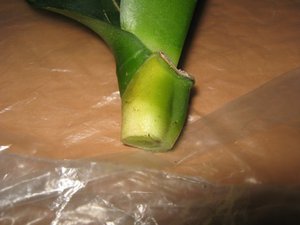 The orchid can be reanimated only if it is determined in time that its roots are not in order. This can be done according to the following criteria:
The orchid can be reanimated only if it is determined in time that its roots are not in order. This can be done according to the following criteria:
- Aerial roots have noticeably darkened, softened or dried up;
- The leaves have lost their elasticity, which does not return even after watering;
- Traces of green algae or sporulation appeared on the walls of the pot;
- If the root system has rotted, then the aerial part of the plant is loose.
When at least one of these signs appears, you need to check the condition of the roots by pulling the plant out of the ground. So it will be possible to determine how many healthy roots are left, and which ones must be removed immediately. Only then can you start saving the plant.
How to save an orchid without roots?
In the event that the root system of Pholenopsis is completely damaged, you can try to grow new roots, and cut off all the damaged ones. Such resuscitation involves the use of high-quality planting land. with sufficient density and good structure. Watering the flower during root growth should be as rare as possible. This should be done only when the soil is completely dry, otherwise the young roots may rot again. In addition, it is advisable to water it with filtered water in the morning.
Rootless orchid resuscitation options
First of all, the damaged flower is removed from the container, if there are still living roots, then they are thoroughly washed. Moreover, when the orchid has a healthy part of its root system, she has a better chance of survival.
When resuscitation is performed, it is necessary to dry Folenopsis in air, the time will depend on the temperature, as a rule, it takes at least three hours for such a procedure. Then it becomes clear what other roots will have to be removed.
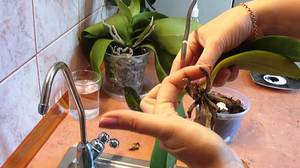 By the way, healthy roots are distinguished by an elastic and dense structure, but rotten ones become sluggish and soft. If you press on a damaged root, then liquid will come out of it.... All dead parts are removed to a living place, while it is recommended to sprinkle the sections with Kornevin and treat with alcohol.Now you can move on to saving the rootless orchid.
By the way, healthy roots are distinguished by an elastic and dense structure, but rotten ones become sluggish and soft. If you press on a damaged root, then liquid will come out of it.... All dead parts are removed to a living place, while it is recommended to sprinkle the sections with Kornevin and treat with alcohol.Now you can move on to saving the rootless orchid.
The easiest way is to reanimate a tropical plant that has many roots that have not rotted. First of all, he will have to be awakened from hibernation. For this you need to put the flower in the lightest place in the apartment... However, direct sunlight should be avoided. You can buy a phytolamp for such purposes.
The roots of the plant, cleaned of rot, are placed in a small pot with a substrate of sphagnum moss and expanded clay. The soil must be constantly moistened, but not much, so that the water does not stagnate at the bottom. In such conditions, the plant is left in a warm room. The temperature in it should be about 25 degrees.
There is another method for saving an orchid without roots. This resuscitation is resorted to when there are few living roots left on the plant. Still this option allows you to restore even a flower with blackened buds... First you need to make a small greenhouse from such scrap materials as:
- Cans;
- Bottles;
- The old aquarium.
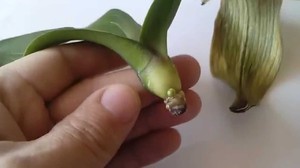 As in the previous version, expanded clay and sphagnum are laid out on the bottom. A flower is planted in this prepared substrate. In this case, you will have to ensure that the temperature in the created greenhouse does not rise above 33 degrees. If you neglect this rule, the roots will begin to rot again.... However, the coolness can also harm Pholenopsis, since molds can appear due to too low temperatures, which will quickly destroy it.
As in the previous version, expanded clay and sphagnum are laid out on the bottom. A flower is planted in this prepared substrate. In this case, you will have to ensure that the temperature in the created greenhouse does not rise above 33 degrees. If you neglect this rule, the roots will begin to rot again.... However, the coolness can also harm Pholenopsis, since molds can appear due to too low temperatures, which will quickly destroy it.
This method is based on the action of carbon dioxide generated in an enclosed space. It is needed for the emergence of new orchid cells. True, once a day the greenhouse should be ventilated... Every month a tropical flower can be fed with Epin and honey solution. Of course, the scattered rays of the sun will become the main healer.
Revitalization period of the home orchid
After completing all the rescue work, the plant will not immediately begin to recover. It may bounce back in a month, and sometimes it takes about a year. With the revival of Pholenopsis in the spring or autumn months, the chances of its salvation are much greater than in winter.
When the appearance of the orchid improves, the leaves turn green again and new roots appear, it is better to stop feeding. Its roots usually develop fairly quickly. Watering after resuscitation of the flower should be slightly reduced so that the soil has time to dry out.
As seen, rotting roots of Folenopsis is a very unpleasant phenomenonwhich can be prevented with proper care. And even if it was not possible to avoid rotting, the plant can be saved.

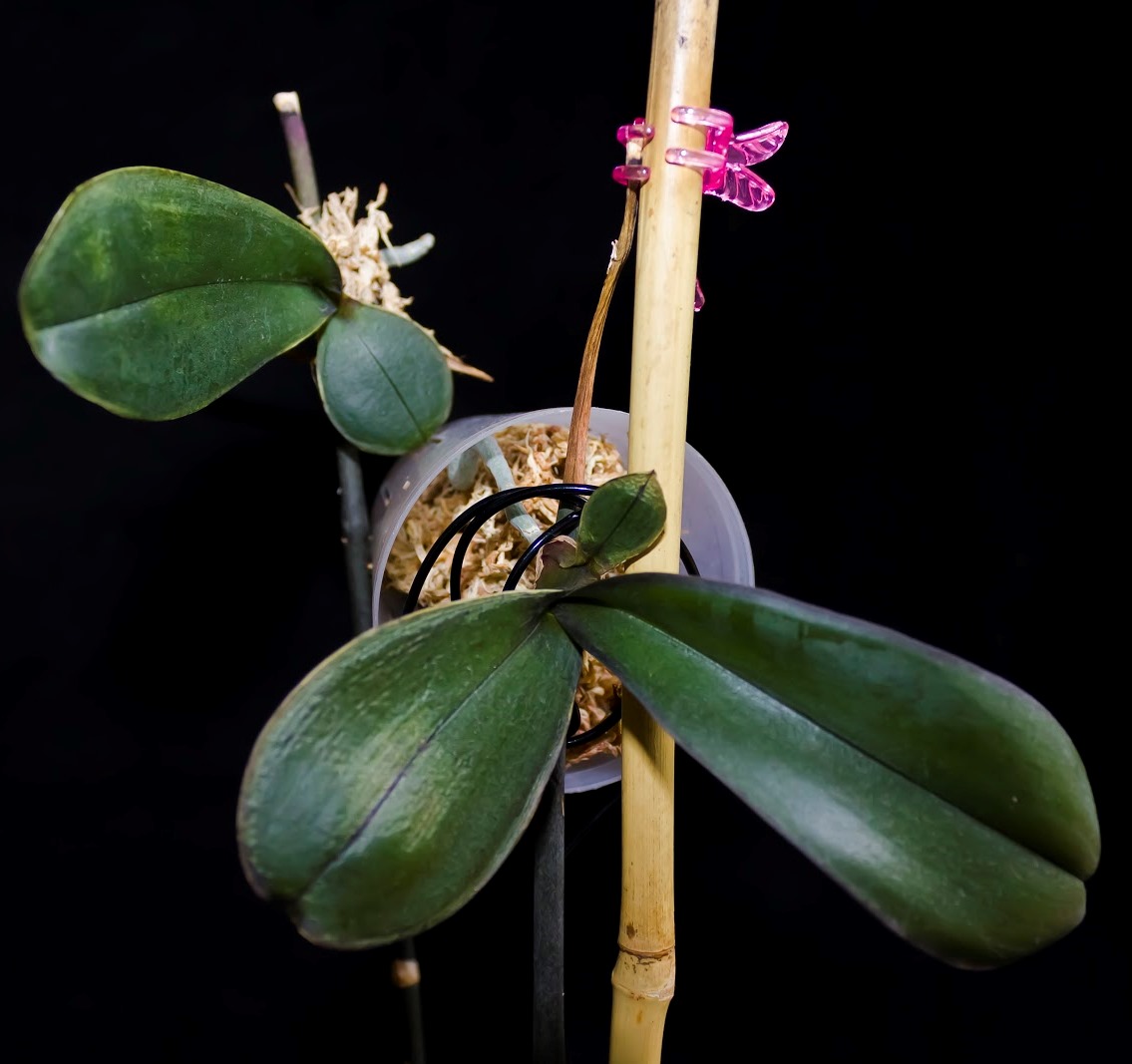

1 comment